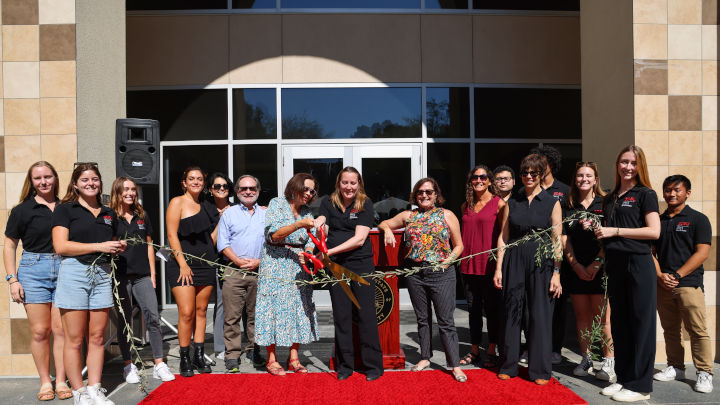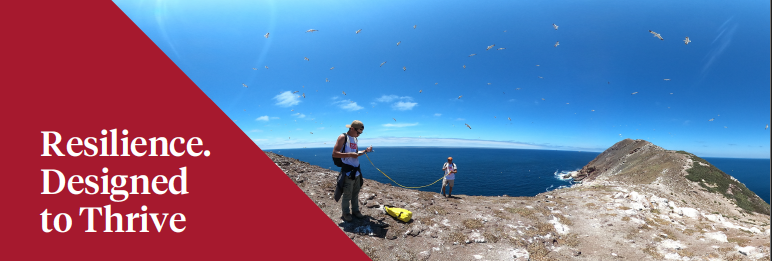Resilience. Designed to Thrive
SDSU is committed to building a resilient and sustainable university through innovative practices. We must develop new revenue streams to meet our scholarly and teaching aspirations, our dedication to community and diversity, and the athletic endeavors of the university. We commit to using our resources with transparency, equity, efficiency, and accountability in alignment with the university's goals. As citizens of a larger global community, SDSU proudly embraces the principles of responsible environmental stewardship.
Metrics of progress:
- Revenue raised from non-state sources
- Improvements in internal resource management processes
- Achievements related to sustainability

Record levels of coverage, views and an improved communications ecosystem
The university launched a brand redesign and introduced new, centralized communications and marketing tools and resources, many of which are available through Brand Portal, to support faculty and staff in promoting their research, college and department successes and student achievements to local, national and international audiences.
All Activities
| Description | Status |
|---|---|
ACTIVITY #8By December 2021: Develop a one-year revenue plan for the following entities with immediate areas of opportunity and planning (follow up with an additional four-year plan by Fall 2022). |
COMPLETE
|
ACTIVITY #9
By December 2020: Develop a structure that promotes entrepreneurial aspirations, which includes a competitive revenue generating proposal process for each college. |
IN PROGRESS
|
ACTIVITY #10
By December 2020: Develop and launch a comprehensive brand strategy for SDSU, which will directly benefit our ability to create and generate new financial support for the university. This strategy should build on the strengths of SDSU Athletics, enhance public-private partnerships (P3s) and philanthropy, and would contribute to student recruitment. |
COMPLETE |
ACTIVITY #11
By December 2020: Realign the marketing initiatives led and/or managed by Strategic Communications and Public Affairs (StratComm) with the outcomes of the strategic plan, to include the creation of a centralized brand management portal and a revision of the university’s logo. |
COMPLETECombined with Activity 10; launched new logo and Brand Portal. |
All Activities
| Description | Status |
|---|---|
ACTIVITY #12By December 2020: Identify areas to advance synergies for shared services across divisions and other units, and develop an organizational plan. |
COMPLETEHired Director of Shared Services. |
ACTIVITY #13
By June 2021: Support and enhance the viability and excellence of SDSU’s auxiliaries through a plan that continues to enable each unit to provide opportunities for students, faculty, staff, and community partners while invigorating the economic success of the university.
|
COMPLETE
Combined w/Activity 8; all auxiliaries presented individual revenue plans in 2021/2022 and are working to execute plans. |
ACTIVITY #14
By June 2021: Develop and align a process for Multi-Year Objective Setting and Budget Planning for the university. |
IN PROGRESS |
Additional Accomplishments
Increased faculty representation on the President’s Budget Advisory Committee (PBAC)
Created SDSU Budget Hub as a central location to host budget information including budget committee updates, budget processes, budget dashboards, budget reports, and budget training resources. Continued to provide budget update communications and hosted budget town hall meetings.
- Assess current space utilization and allocation practices, integrate lessons learned from the global pandemic, and explore best practices to increase strategic and effective use of space (i.e., use of hoteling spaces, shared labs, multi-year planning for new faculty, etc.)
- Recommend a process for considering proposed reallocation of space when/if space becomes available and develop document templates and procedures to ensure uniformity and engender trust and transparency for space transactions.
- Recommend alternate budget resource and space support models via benchmarking of peer and aspirational institutions and consultation support by a third-party firm.
- Support the development of transparent, consistent processes and policies for reviewing space utilization going forward.
- Shared Services implementation plan for procure-to-pay functions in College of Sciences.
- With a goal of unifying Information Technology at San Diego State University (SDSU), a new position of Chief Information Officer (CIO) was established in 2019. Reporting directly to the University President, the CIO is the senior technology strategist and leader for the university. The CIO provides direct oversight of the University’s technology infrastructure, enterprise systems and services, and serves as a member of the President’s Cabinet. The CIO works in close collaboration with senior leadership to help shape the vision, provide policy direction, and lead in the development of strategies in technology to support and advance the University’s strategic goals in educational, research, and administrative functions. The CIO has primary responsibility for the delivery of campus wide IT solutions and overall operational effectiveness of technology on campus. With a focus on assessing the effective investment in and use of technology, and improving the efficiency of SDSU through technology solutions, the CIO position analyzes, prioritizes, and develops immediate and long-term strategies. The CIO provides managerial oversight for all IT units including academic and research technology, administrative computing, campus hardware and software, and user services; and develops and controls annual operating budget for IT to ensure it is consistent with overall strategic objectives of the University.
- The decision to formally integrate various campus IT services into a unified OneIT Community was made following an external assessment of industry best practices. Establishing the OneIT Community addresses findings from both the most recent WASC report, as well as the 2017 Moran Technology Consulting report “External Review of University IT Resources.” This decision was supported by the 2018 “Research & Creative Activities IT Survey” conducted by the Division of Academic Affairs and was announced to the campus community via a Strategic Communications press release.
- The creation of this unified OneIT Community resulted in increased efficiency and collaboration across IT personnel. This includes prioritizing funding to support mission critical resources, such as the SDSU Data Center. Establishing the OneIT Community also made possible the consolidation of help-desk support across all colleges and IT units through the implementation of the ServiceNow service management tool. These enhancements resulted in more reliable and consistent information technology governance, infrastructure, access, and support.

Sustainability Drives our Future
The Office of Energy and Sustainability, the annual campus-wide sustainability summit and other new sustainability efforts established, to include the Sustainability Summit, an annual effort to highlight sustainability efforts through presentations from students, faculty, staff and community leaders.
All Activities
| Description | Status |
|---|---|
ACTIVITY #15By December 2021: Designate executive-level leadership to develop and provide oversight of SDSU’s Sustainability Efforts. |
COMPLETEEstablished Office of Energy and Sustainability, and President’s Sustainability Advisory Committee. |
ACTIVITY #16
By June 2022: Update the University Climate Action Plan, inclusive of all campus locations, with defined benchmarks until June of 2025.
|
IN PROGRESS |
ACTIVITY #17
By June 2022: Develop Guiding Principles for Sustainability that include local and international standards (as referenced in the Associated Students Carbon Neutrality by 2030 Recommendations) to be reviewed on an annual basis. |
IN PROGRESSPending approval of committees |
Additional Accomplishments
Commissioned Carbon Neutrality Feasibility Study in collaboration with and financial support from Associated Students
Developed contractual relationship with third-party partner to install and manage electric vehicle (EV) charges on all SDSU campuses
Established an annual campus-wide sustainability summit

